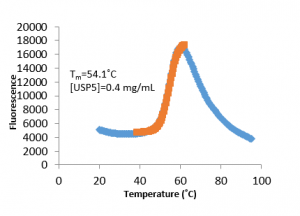It’s important to have more than one assay in place to validate experimental results. In addition to the fluorescence polarization assay, I am also trying to develop a differential scanning fluorimetry (DSF) assay. DSF measures the interaction of small molecules to the protein as the protein progressively unfolds. The melting temperature of USP5 Zf-UBD is around 54-55˚C, so it is quite stable. Hopefully, I will see the melting temperature increase in the presence of inhibitors, indicating that inhibitors are indeed binding USP5 and stabilizing it. More details on this experiment can be found on Zenodo.

Unfortunately, I did not see stabilization of USP5 Zf-UBD in the presence of a ubiquitin RLRGG peptide as I expected. This is most likely due to the low affinity of the peptide to the protein domain. Next, I will continue optimizing buffer conditions and repeat the peptide titration at higher concentrations. I hope to see a significant change in the melting temperature of USP5 Zf-UBD with increasing peptide concentrations. DSF can be a useful assay to verify that inhibitors are actually binding to USP5, but it is not a sensitive assay. I will need a more sensitive assay down the road, such as SPR or ITC. More on this later!
